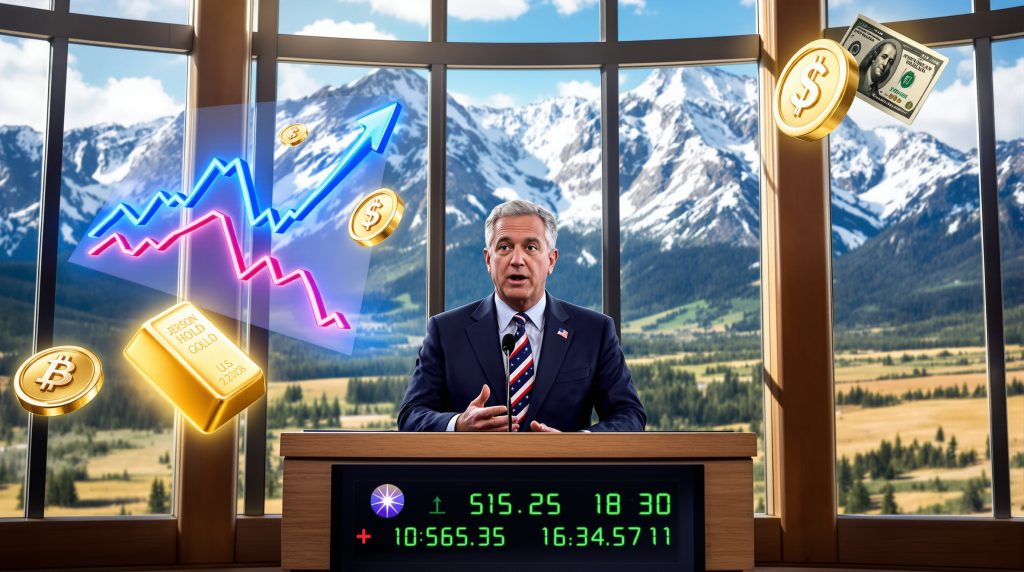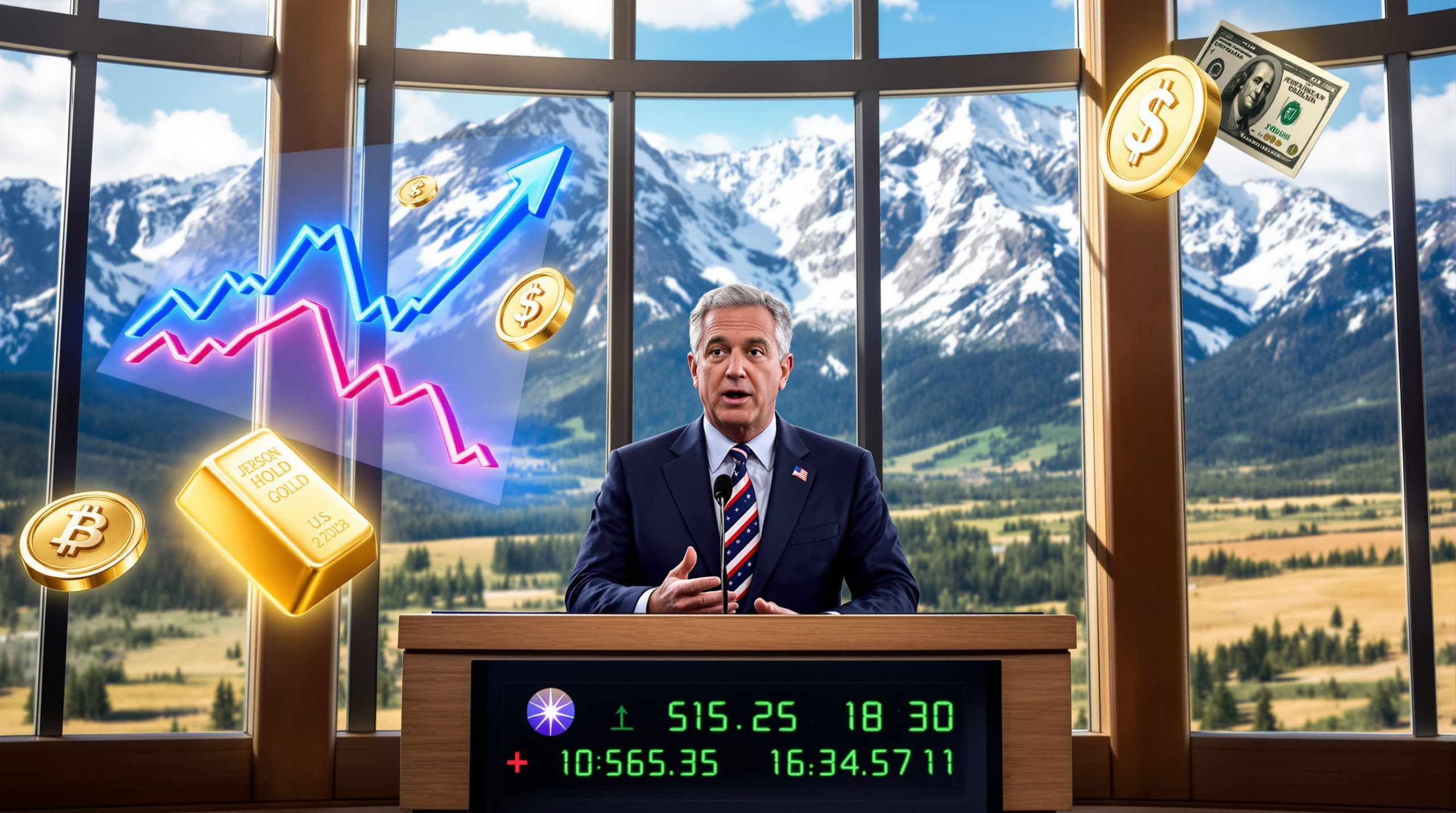The Shifting Fed Narrative: Understanding Powell's Recent Signals
Jerome Powell's recent remarks at the Jackson Hole Economic Symposium marked a significant shift in the Federal Reserve's communication strategy. The Fed Chair acknowledged an evolving "balance of risks" between the twin goals of controlling inflation and maintaining employment levels. This careful recalibration comes after months of messaging that prioritized inflation control above all else.
While Powell offered no explicit policy announcements, financial markets interpreted his comments as a signal that the Fed is preparing to ease its restrictive monetary stance. This perceived "dovish pivot" reflects the delicate balancing act the Federal Reserve must maintain between its dual mandate components: price stability and maximum employment.
The subtlety in Powell's language is notable – suggesting potential policy adjustments without committing to specific actions. This approach allows the Fed to maintain flexibility while signaling to markets that it recognizes changing economic conditions.
What Changed in Powell's Jackson Hole Messaging?
Powell's tone represented a marked departure from previous statements that prioritized inflation control as the primary concern. After consistently defending restrictive rates as necessary for price stability, his acknowledgment of a "shifting balance of risks" suggests the Fed now sees employment concerns as equally pressing.
This recalibration comes amid evidence that the Federal Reserve's aggressive rate hiking cycle may have accomplished much of its intended effect on inflation, though price pressures remain above the Fed's long-term target. The shift also follows significant revisions to employment data that painted a weaker picture of the labor market than previously understood.
Historically, the Fed has used its communications strategy to prepare markets for policy shifts. By gradually adjusting its language before making formal policy changes, the central bank aims to avoid shocking financial markets with unexpected decisions.
Key Economic Indicators Influencing the Fed's Perspective
Several economic indicators have likely influenced the Fed's evolving position. While inflation has been gradually trending toward the central bank's target, it remains stubbornly above the 2% goal that was formally established in 2012. The Producer Price Index recently registered nearly a full percentage point higher than economist expectations, suggesting underlying price pressures persist.
Perhaps most significantly, labor market data revisions revealed substantial overstatements in previous job creation reports. These revisions indicated that hundreds of thousands of jobs that were previously reported never actually materialized, painting a much weaker employment picture than originally understood. This data discrepancy was serious enough to prompt leadership changes at the Bureau of Labor Statistics.
The combination of these factors – persistent inflation alongside a weaker-than-reported labor market – creates a challenging environment for monetary policy. The Fed must now consider whether maintaining high interest rates to combat inflation might cause unnecessary damage to employment.
Additional economic growth metrics show concerning signs of potential slowdown, further complicating the Fed's decision-making process. This confluence of factors has apparently tilted the Fed's risk assessment away from inflation concerns and toward growth and employment considerations.
Market Reactions and Rate Cut Expectations
Financial markets responded swiftly and decisively to Powell's Jackson Hole remarks, interpreting them as a clear signal that rate cuts are on the horizon. This reaction demonstrates the market's sensitivity to even subtle shifts in Federal Reserve communications.
How Did Financial Markets Respond to Powell's Speech?
Equity markets surged immediately following Powell's remarks, with major indices posting significant gains. This reaction reflected investors' belief that monetary policy easing would provide support for corporate earnings and economic growth.
Interest rate futures quickly adjusted, pricing in a higher probability of near-term rate cuts. This repricing occurred across the yield curve, with particular emphasis on expectations for the Federal Open Market Committee's September meeting.
The U.S. Dollar Index experienced a notable decline, dropping 1.1% in a single day from 98.7 to 97.6. This movement aligns with typical currency market reactions to expected interest rate reductions, as lower rates generally make a currency less attractive to international investors seeking yield.
The Treasury yield curve steepened noticeably as markets adjusted to new rate expectations. Short-term yields fell in anticipation of imminent rate cuts, while longer-term yields remained more stable, reflecting persistent inflation concerns.
In the precious metals market, gold prices analysis maintained positions near all-time high levels while silver approached the psychologically significant $40 level. These movements reflect precious metals' traditional role as gold as inflation hedge and their inverse relationship with the U.S. dollar.
What Are Current Rate Cut Probabilities?
Market expectations for a September rate cut increased dramatically following Powell's speech, with probability estimates rising from approximately 75% to nearly 90%. This shift indicates strong market conviction that the Federal Reserve will begin easing monetary policy at its upcoming meeting.
Traders are now pricing in multiple cuts through the remainder of 2025, with the magnitude of expected cuts growing from traditional 25 basis point increments to potentially more aggressive 50 basis point reductions. This expectation suggests markets anticipate a sustained easing cycle rather than merely a minor adjustment.
Forward-looking indicators, including futures contracts and options pricing, suggest markets are positioning for a significant shift in monetary policy. These expectations will likely influence the Fed's own projections, with the central bank's "dot plot" of interest rate forecasts due for revision at upcoming meetings.
It's worth noting that market expectations don't always align with eventual Federal Reserve actions. The central bank maintains its data-dependent approach and will continue evaluating economic conditions through its September meeting.
Potential Economic Consequences of Rate Adjustments
Any adjustment to the Federal Reserve's interest rate policy carries significant implications for both inflation dynamics and broader economic growth. Understanding these potential consequences is essential for investors and economic participants.
How Would Rate Cuts Impact Inflation Dynamics?
Recent inflation data presents a challenging backdrop for potential rate reductions. While inflation has moderated from peak levels, it has been trending upward in recent months, moving further from the Fed's 2% target.
The implementation of new tariffs presents an additional inflationary concern. Many companies initially absorbed these costs by utilizing inventory buffers and delaying price increases. However, these mitigating factors are diminishing, potentially allowing tariffs impact on markets to filter more directly through to consumers.
Powell's characterization of inflation as a "one-time shift in price level" bears striking similarity to the "transitory" inflation narrative that prevailed during 2021-2022. This framing may indicate the Fed's willingness to tolerate higher inflation in the near term while focusing on other economic concerns.
The Fed has subtly reframed its 2% inflation target as a "longer-run objective" rather than an immediate goal. This linguistic shift provides policy flexibility but raises questions about the central bank's commitment to price stability in the short term.
If implemented too aggressively or prematurely, rate cuts could potentially reignite inflationary pressures by stimulating demand before supply-side constraints have fully resolved. This risk creates a delicate balancing act for monetary policymakers.
What Are the Implications for Employment and Growth?
Labor market cooling has become a greater concern for policymakers following significant data revisions. These revisions revealed that job creation had been substantially overstated in previous reports, suggesting the employment situation may be more precarious than previously understood.
Rate cuts typically aim to stimulate hiring and business investment by lowering borrowing costs throughout the economy. This stimulus effect can support employment growth, though its impact often manifests with a lag of several months or longer.
Economic growth projections have been revised downward for upcoming quarters, increasing pressure on the Federal Reserve to support the economy through more accommodative monetary policy. Declining growth combined with persistent inflation creates a challenging scenario known as "stagflation" that monetary policy alone struggles to address.
The risk of policy error has increased with conflicting signals between inflation and employment data. Cutting rates too soon might fuel inflation, while maintaining restrictive policy too long could unnecessarily damage employment and growth.
Historical precedent suggests that central banks often prioritize employment concerns over inflation when faced with conflicting signals, particularly when inflation appears to be moderating from peak levels.
Currency and Precious Metals Outlook
Interest rate policy decisions have profound implications for currency valuations and alternative assets like precious metals. These relationships are particularly important for investors seeking to position portfolios for changing monetary conditions.
How Will Rate Cuts Affect the US Dollar?
The dollar typically weakens when interest rates decrease or are expected to decrease. This relationship stems from reduced yield advantages for dollar-denominated assets, making them less attractive to international investors seeking returns.
International capital flows may shift away from dollar-denominated assets as yield differentials narrow between the United States and other developed economies. This reallocation can accelerate dollar weakness, creating a self-reinforcing cycle.
Trade balances could be significantly impacted by changing currency valuations. A weaker dollar generally makes U.S. exports more competitive internationally while increasing the cost of imports, potentially improving trade deficits but adding to inflationary pressures.
Dollar weakness typically supports commodity prices denominated in USD through two mechanisms: reduced costs for international buyers and increased appeal as alternative stores of value. This relationship is particularly evident in energy and precious metals markets.
Global central bank policies will influence relative dollar strength in response to Fed actions. If other major central banks maintain restrictive policies while the Fed eases, dollar weakness could be more pronounced due to widening interest rate differentials.
What Does This Mean for Gold and Silver Markets?
Gold historically performs best during periods of negative real interest rates – when inflation exceeds nominal interest rates. This environment reduces the opportunity cost of holding non-yielding assets while increasing demand for inflation hedges.
Silver exhibits higher volatility or "beta" than gold during major market moves, often amplifying gold's price direction. This characteristic makes silver particularly responsive to monetary policy shifts, with potential for outsized moves during transitional periods.
Current silver prices remain 20-25% below previous all-time highs, suggesting potential upside compared to gold, which is already trading near record levels. This relative valuation discrepancy could drive investor interest in silver as a leveraged play on precious metals strength.
Both metals benefit from dollar weakness, as their inverse relationship with the U.S. currency makes them more affordable for international buyers when the dollar declines. This relationship often strengthens during periods of monetary policy easing.
Institutional positioning in metals markets has increased in anticipation of policy shifts, reflecting professional investors' view that precious metals offer portfolio protection during periods of monetary easing and potential inflation concerns.
The September Fed Meeting: Decision Factors
The Federal Reserve's September meeting represents a critical juncture for monetary policy. Several key factors will influence the committee's decision-making process.
What Economic Data Will Influence the September Decision?
Upcoming inflation reports will be critical in determining the timing and size of potential cuts. The Personal Consumption Expenditures (PCE) Price Index, the Fed's preferred inflation gauge, will receive particular scrutiny for signs of moderating price pressures.
Employment data, particularly the August jobs report, will carry significant weight in the decision-making process. Following recent data revisions, the Fed will closely monitor both headline job creation numbers and underlying metrics like labor force participation and wage growth.
Consumer spending and retail sales figures will provide important signals about economic momentum. As consumer activity represents approximately 70% of U.S. economic output, these indicators offer crucial insights into broader economic health.
Manufacturing and service sector activity metrics, including Purchasing Managers' Indices (PMIs), will reveal broader economic conditions. These forward-looking indicators help policymakers gauge business sentiment and activity across major economic sectors.
Housing market data will demonstrate the impact of prolonged high interest rates on a particularly rate-sensitive sector. Mortgage applications, home sales, and construction activity all provide valuable insights into how monetary policy is affecting real economic activity.
How Might Geopolitical Factors Impact Fed Decision-Making?
Trade policy developments and tariff implementations could significantly influence inflation expectations. As new tariffs work through supply chains, their impact on consumer prices becomes an important consideration for monetary policy.
Global growth concerns may factor into international financial stability considerations. Weakness in major trading partners or emerging market stress could amplify domestic economic challenges, potentially encouraging more accommodative policy.
Energy price volatility could affect both inflation and growth projections. Oil and natural gas prices influence transportation costs, manufacturing expenses, and consumer spending patterns, creating complex implications for monetary policy.
Election-year dynamics may create additional scrutiny of Fed independence. Central banks typically strive to avoid the appearance of political influence, potentially affecting the timing or communication of policy changes during election seasons.
International monetary policy coordination, while often overlooked, remains an important factor. Major central banks consider the actions of their counterparts when formulating policy to avoid destabilizing currency movements or capital flows.
Long-Term Investment Implications
The shifting interest rate environment has significant implications for investment strategies across asset classes. Understanding these dynamics helps investors position portfolios appropriately for changing monetary conditions.
How Should Investors Position for a Changing Rate Environment?
Fixed income strategies typically require adjustment during policy transition periods. Bond durations, credit quality exposures, and sector allocations may need recalibration as interest rate expectations shift.
Equity sector rotation often occurs as rate expectations evolve. Historically, rate-sensitive sectors like real estate, utilities, consumer discretionary, and technology tend to outperform during rate-cutting cycles, while financial sector performance varies depending on economic conditions.
Real asset allocations may benefit from inflationary concerns and negative real rates. Categories like commodities, infrastructure, and inflation-protected securities often perform well when monetary policy becomes more accommodative.
Portfolio duration management becomes increasingly important during rate cutting cycles. Bond holdings with longer maturities typically experience larger price changes in response to interest rate movements, creating both risks and opportunities.
Diversification across asset classes helps mitigate policy uncertainty risks. Maintaining exposure to multiple investment categories with different monetary policy sensitivities can reduce portfolio volatility during transitional periods.
What Historical Parallels Exist for the Current Situation?
Previous Fed policy pivots have often led to significant market repricing. The initial rate cut following a tightening cycle typically generates positive market responses, though the sustainability of these rallies varies based on underlying economic conditions.
The 2019 "mid-cycle adjustment" provides a recent example of limited rate cuts. During this period, the Federal Reserve implemented three quarter-point reductions before pausing, demonstrating that not all easing cycles involve extended sequences of cuts.
The 2007-2008 rate cut cycle demonstrates how quickly policy can shift during economic deterioration. The Fed moved from gradual 25 basis point reductions to emergency 75 and 100 basis point cuts as financial conditions deteriorated, highlighting the potential for accelerated policy responses.
The 1990s saw successful "soft landing" scenarios that avoided recession despite tightening cycles. These episodes demonstrate the possibility of transitioning from restrictive to neutral monetary policy without triggering economic contraction.
Historical data shows markets typically rally following initial rate cuts, but outcomes vary significantly based on underlying economic conditions. Rate cuts implemented to prevent recession generally produce more sustainable rallies than those responding to already evident economic contraction.
FAQ: Interest Rates and Market Impact
When is the next Federal Reserve meeting?
The Federal Open Market Committee (FOMC) is scheduled to meet on September 17-18, 2025, when they will make their next interest rate decision based on evolving economic data and conditions.
How do interest rate cuts affect mortgage rates?
While mortgage rates are influenced by Fed policy, they don't move in perfect lockstep with the federal funds rate. Mortgage rates are more directly tied to 10-year Treasury yields and can sometimes move in anticipation of Fed actions rather than after them.
What sectors typically benefit most from interest rate cuts?
Historically, rate-sensitive sectors like real estate, utilities, consumer discretionary, and technology often outperform during rate-cutting cycles, while financial sector performance can be mixed depending on the economic backdrop.
How many rate cuts are expected in 2025?
Market pricing currently suggests expectations for 3-4 quarter-point rate cuts through the remainder of 2025, though this outlook continues to evolve with incoming economic data and market volatility insights.
What is the relationship between interest rates and gold prices?
Gold typically performs best when real interest rates (nominal rates minus inflation) are negative or falling, as this reduces the opportunity cost of holding non-yielding assets while increasing inflation hedge demand. The US economy outlook significantly impacts these relationships.
Ready to Get Ahead of Major ASX Mineral Discoveries?
Don't miss out on significant investment opportunities in the resource sector. Discover how Discovery Alert's proprietary Discovery IQ model delivers real-time alerts on major ASX mineral discoveries, turning complex data into actionable insights at https://discoveryalert.com.au/discoveries/.




